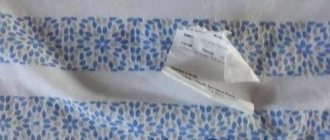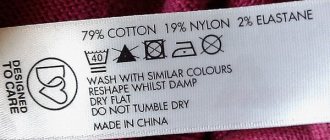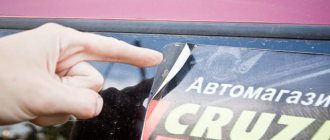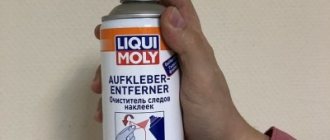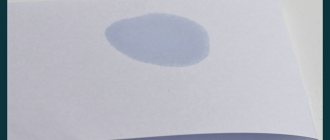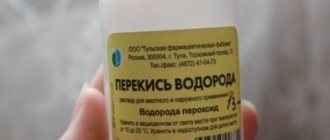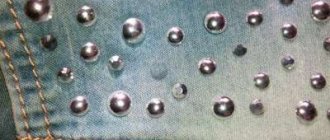Stickers on clothes are a kind of manufacturer identifier and an additional way to attract the attention of a potential buyer to the brand. Not long ago I was choosing baseball caps for my sons for the summer. Huge round iridescent price stickers were on the visors. It doesn’t seem to be a big deal, peel them off and wear them with pleasure. But how do you remove the glue from the sticker? It eats into the fabric, and if you don’t get rid of it, it will collect all the dust and small debris. By the way, I still bought the baseball caps and removed the glue from the label. I’ll tell you in more detail how and with what I did it.
How to remove sticky adhesive from other materials?
To remove traces of glue, it is important to consider the material on which the sticker was glued. A variety of cleaning methods are used
Tools used
The adhesive base can be removed manually using detergent.
If this does not help, then use:
- oil: sunflower, corn, olive;
- alcohol;
- vinegar;
- scotch;
- acetone;
- household hair dryer;
- citrus.
Oil
The method is suitable for surfaces that do not absorb fats.
Sequence of procedure:
- The label is soaked in oil and left for 10 minutes.
- Soaked paper is removed with a knife or plastic scraper.
- The product is washed with soap and water, and the remaining glue is removed.
If the house runs out of oil, you can take 20-40 g of mayonnaise.
Alcohol
Use pure homemade alcohol tincture
Use pure homemade alcohol tincture, store-bought vodka, deodorants.
Procedure:
- A cloth napkin is soaked in the composition.
- Wipe off the adhesive base.
- Rinse thoroughly with hot water.
This method is not suitable for all materials; you should first check it on an inconspicuous fragment.
Vinegar
Suitable for most surfaces, it does not contain “aggressive” chemicals.
Algorithm of actions:
- Apply table vinegar to a cloth.
- Wait 7-10 minutes: the paper will become limp during this time.
- Carefully remove the top layer.
- The glue is wiped with a wet cloth.
If the procedure does not help, repeat several times until the adhesive stain completely disappears.
Scotch
This method will help when the sticker is “fresh” and can be easily removed. Tape is glued to the top and torn off with a sharp movement.
The procedure is carried out several times, rinsing the remaining adhesive base with water.
Acetone
Solvent and a hair dryer will help in the fight against factory price tags. The label is heated with hot air and removed with a scraper. The remaining adhesive base is wiped off with a cloth soaked in acetone.
Hairdryer
Suitable for metal and durable materials.
Procedure:
- The surface is heated.
- They take off the price tag.
- Soak in oil or fat and leave for 10 minutes.
- Wash with detergent.
A household or hair dryer is suitable for warming up.
Citrus
You will need several lemons to remove the paper. The label is soaked in lemon juice and left for 10-20 minutes. The paper is removed with glue and washed with soap base.
Removing stickers from clothes
Using an iron or hairdryer, heat the required area.
It is possible to remove price tags from items at home.
A few common options:
- Using an iron or hair dryer, heat the required area. A cloth is placed on the clothes so as not to spoil the surface. It is also necessary to read the composition of the fabric: some materials should not be subjected to heat treatment.
- Use nail polish remover without acetone. The sticker is carefully impregnated with it. But it’s worth checking first on an inconspicuous area of clothing, otherwise your favorite item may lose color.
- Clothes are placed in the freezer for 25-40 minutes. During this time, the glue “dries out” and the thermal pattern is easily removed by hand.
To remove the sticky layer, use tape, laundry soap and detergents.
From furniture and wood
The adhesive layer must be removed especially carefully if the furniture has a polished surface. Careless actions will lead to damage to interior items.
It is important to choose the right cleaning method:
- Heat treatment. The sticker is heated with a hairdryer for several minutes. The edge is lifted with a flat plastic object. Moisten a cloth with a polishing solution and wipe the surface of the furniture.
- Sunflower oil. The paper is moistened and left for several minutes. Scrub with a plastic object (knife). Furniture is wiped with soapy water.
- Aerosol. Spray on adhesive paper and leave for 2-3 minutes, then remove. It does not harm furniture and polishes the surface.
Old stickers are left for 10-15 minutes and soaked in alcohol.
From metal
Peeling the sticker off metal products without leaving a trace is not difficult. The methods listed above are suitable for this.
Means and materials for processing:
- hair dryer;
- vinegar;
- solvents;
- industrial products;
- oil;
- lemon juice.
- alcohol;
- alcohol.
The metal surface is durable and therefore difficult to damage.
Remove glue marks while they're fresh.
It is very important to clean the sticky area as soon as the label is removed. Otherwise, due to the accumulating dust, a stain will appear, which will require considerable effort to remove. Therefore, when you return home after a successful shopping trip and unpack your purchases, immediately start removing the labels.
You should not postpone this procedure: for example, socks purchased “in reserve” will acquire unsightly sticky marks if you put them in a closet and take them out after a while. On the other hand, freshly applied labels come off without problems and leave almost no adhesive marks.
In addition to the recipes listed above, there is another simple solution that involves using nail polish remover. We recommend using a product that does not contain acetone, otherwise the product may be damaged. Simply apply the liquid to the problem area - this will help get rid of dirt and stuck paper residues.
The choice of cleaning agent and cleaning method depends entirely on the surface that needs cleaning. Hard surfaces are easier to clean than clothes and upholstered furniture. Therefore, the cleaning process has various nuances.
How to Remove Label and Tape Stains from Fabric and Other Surfaces
All kinds of stickers and labels are similar in composition to plaster. In some cases, it is necessary to deal with contaminants left by labels on various surfaces
Removing them can also be difficult, so it is important to choose exactly the folk remedy that is suitable for the specific surface being treated.
Removing sticker adhesive from clothes
- Marks from stickers on clothes are washed off with concentrated laundry soap. First, lather the stained area well, and then wash the clothes in a machine or by hand.
- Durable fabrics without prints or designs can be treated with alcohol. The product is applied to a cotton pad, which is used to wipe the contaminated area.
Cleaning plastic and plastic from adhesive plaster
Dirt from labels on plastic and plastic can be easily removed with vegetable or essential oils (essentials must be checked first on a small area so as not to spoil the product).
- Apply a small amount of product to a clean rag, and then try to wipe off the marks from the labels.
- You can leave the cloth in place of the sticky layer for 2 minutes. The oil will soften the glue from the stickers, and they can be easily removed with a simple napkin.
Recommendations
- Apply vegetable oil to the contaminated area and leave for about 2 hours.
- Heat the decal with warm (not hot) air from a hair dryer until the adhesive becomes soft and can be easily removed.
- Wash the area with a cloth and warm, soapy water.
It can be quite difficult to remove labels from dishes, and sometimes you have to use different “grandmother’s” methods to achieve results. At the same time, to achieve 100% effect, you may need to combine several methods, but the cleanliness of kitchen utensils is worth all the effort.
Folk remedies Recipes for masks At home Hair loss in women How to stimulate growth Causes of hair loss Hair loss in men Review of vitamins Helpful tips
How to remove iron-on adhesive from clothing
- Dryer. Place the item in the unit and set the temperature to high. When exposed to heat, the adhesive base of the decoration will become more pliable. And you can remove the thermal sticker without much effort.
- Warming up with an iron. Lay out the clothes on a flat surface, place sheets of paper under the image (both the front and back sides). Iron the image with an iron set to the highest heat setting until the decal transfers to the paper.
- Hair dryer or freezer. Not all items can be exposed to high temperatures, and for such cases, use a hairdryer to heat the base of the sticker, or place the item in the freezer for 2–3 hours. In both cases, the surface of the design will begin to crumble and peel off and you will be able to “scrape” it off the surface of the fabric.
The same methods will help remove a drawing or inscription applied with thermal printing from things.
To remove the inscription from a T-shirt, you can use special products that are available in stores. In this case, everything is done according to the instructions. Let's try simple and cheap ways to remove patterns from clothes at home:
- Wash. Wash in a washing machine at the maximum temperature allowed for the fabric. However, the problem will not be solved automatically. After washing, the design will simply become less durable and can be erased mechanically.
- Iron. Chewing gum and plasticine are removed using the same method. Place paper napkins or towels on and under clothing. The entire design is transferred to an ironing board, the iron is turned on and the unwanted inscription is ironed until it remains on the napkin. When the wipes become dirty, they need to be replaced with new ones.
- Freezing. Low temperatures destroy the properties of the glue. Place the items in a bag and place them in the freezer with the pattern facing up. After 2 hours, remove it and mechanically scrape it off.
- Hair dryer. The method is an alternative to ironing for those fabrics that cannot withstand high temperatures. Heat the desired ornament and remove it mechanically.
The methods are great for removing iron-on adhesive or heat-printed images from clothing.
Heat
Often high temperatures help solve such problems. The situation when you need to remove a design from a T-shirt or sweatshirt is no exception. Here's how it works:
- Place the item you want to remove the pattern on on a clean, flat surface. An ironing board is best.
- In the middle of the item, that is, between the front and back of the clothing, place a towel or strong cardboard so that the item does not get damaged when heated.
- Be sure to read the maximum permissible heating temperature of the item before heating it. Do not overdo it to avoid damaging the fabric.
- Turn on the hair dryer and, holding it close to the sticker, begin to heat it. When exposed to high temperatures, the sticker will begin to peel away from the fabric.
Solvent
You need to be careful when creating a drawing using a solvent. This composition can not only irritate the skin, but also lead to damage to the fabric structure
As a result, the material will eventually begin to tear without reason and stretch.
It is not recommended to use acetone or thinner on synthetics. The aggressive components of these products dissolve the fibers of things.
They are also used to remove any remaining adhesive after removing a sticker.
How to remove stickers from clothes:
- Wear gloves and protect your respiratory tract. The fumes released may be harmful to the skin and respiratory tract.
- Take the solvent and test it on an inconspicuous area of the T-shirt. If the product reacts well with the product, proceed with removal.
- Apply the solvent to the image using a sponge. Don't pour too much of it, otherwise the T-shirt will be hopelessly ruined. In this technology you need to know when to stop.
- Wait a while. Usually 5–15 minutes is enough. The paint will begin to dissolve and can be easily washed off with water.
The manipulation may have to be repeated more than once. And each time it should be completed with a thorough wash, and not just rinsing in clean water.
Machine or hand wash the item using detergent to remove the solvent from the fabric.
Precautionary measures
If you decide to go on the attack, armed with industrial solvents or machine fuel, then follow these precautions:
- wear rubber gloves;
- work only in a well-ventilated area, as their vapors are toxic;
- be sure to check the reaction of the product material in an inconspicuous area;
- if the item is small in size and you will be processing it above a table or in another place, lay down oilcloth or newspapers to protect the work surface;
- When choosing a special sticker remover, read the instructions carefully before use and use this spray or liquid only for the surfaces specified in it.
Useful tips
Some more useful tips:
Do not apply a new sticker to the fabric immediately after removing the old one. First you need to wash and dry the item completely. In order for the new image to fit perfectly, you should completely get rid of all, even the smallest, traces of the old sticker. This applies to both glue and cleaning agents. Under no circumstances should you use a hot iron without using parchment paper. Be sure to test the effect of aggressive agents on the fabric before removing the sticker. You should always follow the instructions on the clothing label. If you heat the material (polyester) too much, it will simply melt. While working, you should place a soft cloth on the inside of the product. This will help prevent damage to the item.
If this makes the surface too soft, you can use a thin sheet of wood or thick cardboard. If you can’t wash or remove the sticker the first time, you should try other removal methods. It is important to remember that the older the sticker, the more difficult it will be to remove. The stripes are removed using a needle and nail scissors. The threads are cut from the wrong side, and the knots are untangled with a needle.
How to remove a vinyl sticker
You can remove vinyl stickers in the same way as thermal stickers - using heat.
The only difference is that after removing the sticker, you need to wipe the area where the removed pattern was located with vinegar. This will help clean the fabric from any glue residue.
- In addition, you can remove vinyl and other types of stickers using stationery tape. You need to press the adhesive tape firmly onto the image for 2-3 minutes and then quickly remove it. To remove the drawing completely, you will have to repeat the manipulations several times.
Before using tape, make sure that the material from which your item is made does not have an increased tendency to stretch and deform.
We use improvised means
It’s great if the marking is easily separated from the base. But this doesn't always happen. Most often, a sticky mass remains on the base that needs to be removed. This can be done using the tools present in every home.
Fat (oil)
Any oil will do: edible or cosmetic. If they are not available, use margarine, mayonnaise, etc. The essence of the technique is that fat dissolves the adhesive paste. It softens and is easier to remove. The selected product is applied to the remaining glue and left for 5-10 minutes. After this, carefully clean the surface with a soft plastic spatula, an old plastic card, etc.
Alcohol
Alcohols and products containing them are used as effective solvents. The preparation is moistened with a rag, which is used to wipe off the sticky mark. To make the task easier, you can briefly hold the swab soaked in the solution on the stain. But only on condition that the base is not damaged. A wet wipe containing alcohol works in a similar way. True, there is very little of it there, so it will take a long time to rub.
Acetic acid
Another solvent. There is no need to take a concentrated preparation; a 9% solution, which is known as table vinegar, is quite sufficient. They moisten a cotton pad or a suitable cloth with it and apply it to the problem area for 10-12 minutes. Afterwards the base is cleaned and washed with clean water. This method is not always suitable for plastic; it can deteriorate.
Steam
This cleaning is very effective, but is only possible for surfaces that are resistant to high temperatures. To create steam, use a steam generator; if you don’t have one, an iron with a steam function or a regular boiling kettle will do.
Eraser or melamine sponge
Removes adhesive paste residue well. To obtain a quick result, the stain is first soaked in soapy warm water, and after 10-15 minutes, wiped with a rough cloth. After this, rub with an eraser. A melamine sponge works in a similar way. It is a fine abrasive. Therefore, it cannot be used on coatings that may be scratched. Its use on dishes and all objects in contact with food is not recommended.
Melamine sponge Paterra Extra Effect
We have listed the most effective means. In addition to them, other preparations are also used: various solvents, WD-40 liquid, kerosene, gasoline, lighter fluid. Sometimes a slice of lemon or citric acid dissolved in water helps.
Instagram koteykashop
Instagram koteykashop
Wash
Washing helps if the label is already old and is about to fall off on its own, or if the inscription has almost been erased, but a little remains on the product.
So what should you do?
First, try simply washing the item according to the temperature and cycle.
If this does not help, increase the temperature slightly, but the wash cycle should remain the same
Be sure to pay attention to the material; as the degrees increase, many products shrink or, on the contrary, stretch
If you are afraid of ruining your clothes, it is better not to take risks and use other technologies to flatten the design or remove the label from the fabric.
What is not recommended to do
It is not recommended to do the following when cleaning the canvas:
- Prolonged rubbing and scraping will damage the materials.
- When using a caustic product when treating a car body or enclosed space, ventilate more often.
- Be careful with flammable mixtures.
- When working with chemicals, use personal protective equipment.
A number of tips will help you avoid negative consequences.
Fresh marks are easier to remove than old stickiness. The basic rule is to take into account the characteristics of surfaces in order to choose the right cleaning method.
Article information
This article was produced by our experienced team of editors and researchers, who reviewed it for accuracy and comprehensiveness.
Categories: Home and Garden
In other languages:
English: Remove Sticker Residue, Deutsch: Klebstoffreste entfernen, Italiano: Rimuovere i Residui di Colla, Português: Remover Resíduos de Adesivos, Español: eliminar los residuos dejados por las etiquetas, Français: enlever un résidu d'étiquette, 中文: 去除标签残留粘胶, Nederlands: Stickerresten verwijderen, Bahasa Indonesia: Menghilangkan Sisa Stiker, Čeština: Jak se zbavit zbytků lepidla od samolepky, ไทย: ขจัดคราบสติ๊กเ กอร์, ??? : Loại bỏ Keo dính Sót lại từ Nhãn dán, 日本語: シール跡を落とす, Türkçe: Yapıştırma Kalıntısı Nasıl Çıkarılır, हिन ्दी: स्टिकर के अवशेष निकालें (Remove Sticker Residue)
This page has been viewed 361,709 times.
Was this article helpful?
Not really
Ways to deal with sticky marks
Label adhesive can be removed in one of several ways. Let's look at them in order. Firstly, high temperature can come to the rescue. The first thing that comes to mind is to thoroughly warm up the damaged area by blowing hot air on it from a hairdryer.
If the fabric from which you want to remove glue is not too capricious (for example, jeans or a cotton blouse), you can use boiling water. Gently pour water from a kettle over the “disaster” site or soak it in a pan of very hot water. The adhesive substance will quickly steam and come off the material. This method also helps to get rid of chewing gum.
The second cleaning method is to arm yourself with vegetable oil and gently rub the sticky area. The sticky substance will come off, but you will have to deal with the greasy oil residue. In general, it is not necessary to look for unusual folk recipes. Sometimes a regular intensive wash with a high quality powder or liquid detergent is sufficient.
If this cleaning procedure proves ineffective, more creative methods can be used. Try cleaning the stain with kerosene, alcohol or any suitable solvent. First make sure that the potent substance will not harm the tissue itself.
Cleaning various surfaces
When choosing a cleaning product, think about possible side effects. If you are cleaning furniture, you should not use peanut butter, otherwise the greasy stain will be extremely difficult to remove. On the other hand, if you're wondering how to remove stickers from clothes, peanut butter is a good option.
In this case, the matter can be cleaned without difficulty: just apply the oil to the problem area and gently rub it in. When the cleaning procedure is completed, we wash the item in an automatic washing machine in the standard way: this way, the uncleaned residues will be washed off from the fabric for good.
Sometimes it’s not possible to find the right composition right away. In this case, try several options until the result is satisfactory. In any case, the cleaning algorithm is approximately the same and does not depend on the specific cleaning agent.
Apply the composition to the stained area and gently rub in using a cloth or soft-bristled brush. Gradually, pieces of the sticker will begin to fall off. Then we remove them with a cloth or towel. After complete removal of the glue, you should clean the surface: wash clothes and oversized fabric items, wipe furniture with a damp sponge, and also wash hard surfaces.
In a situation where cleaning was carried out using an oil-based composition, use a stain remover that can dissolve grease for the final treatment. This way you can easily get rid of the oil stain.
Afterwards, the salvaged item of clothing should be thrown into the washing machine or washed by hand. Important clarification: it is better to test the selected cleaning composition to make sure that it will not harm the fabric.
We suggest you read: How to remove black mold from the walls in the house
An effective cleaning method is to use lighter fluid. But this method can be dangerous, so use it only in extreme cases.
Four ways to get rid of the inscription
As a rule, the effective measures are those with which the drawing was attached to the thing.
So, experienced housewives recommend arming yourself with:
- iron;
- alcohol;
- hot water.
Some particularly difficult cases will require patience and diligence. Let's start removing the sticker from clothing.
Method 1: Vinyl applique, iron-on sticker
Removing the print from the front of a T-shirt is not difficult. To remove, arm yourself with an iron and two sheets of parchment paper. The first is placed inside the product under the sticker, and the second is placed on top of the image. A heated iron is passed over the vinyl image several times so that the picture sticks to the parchment.
If you pre-moisten the fabric or use an iron with a steam function, the process will go faster.
How to remove applique from delicate fabric that cannot withstand high temperatures? A hairdryer can be used as a heating device. After removing the thermal print, the product is soaked in a solution prepared on the basis of warm water and baking soda, and when dealing with vinyl applique, the place where it was previously located is wiped with a cotton swab dipped in vinegar or nail polish remover.
Method 2: Thermal printing
These types of images can be removed using medical alcohol. First, the product is spread out on a flat, hard surface, and the painted area is carefully washed with a cotton swab soaked in alcohol. It is strictly not recommended to rub the picture. The ideal movement is a swing motion, which creates the effect of clearing the table of crumbs.
The alcohol should not be allowed to dry before the washing process.
Delicate items must be handled with care. If the item is subject to deformation, then the image should be moistened generously with alcohol, and then the clothes should be washed in a machine with added detergent.
If desired, the proposed cleaner can be replaced with vodka or cologne. They also effectively help peel off thermally applied designs. In order not to spoil the clothes, it is advisable to conduct an experiment for a possible negative reaction by dripping the solution onto the wrong side in an inconspicuous place. Otherwise, if a stain remains, you will have to remove it as well.
Method 3: Special markers and paints
Art objects applied to a T-shirt are reduced using a similar method, the same as if we were talking about erasing polish from the surface of a nail. Therefore, most often housewives use nail polish remover, acetone, solvent or alcohol.
Initially, the task is to choose the optimal product that will be suitable for a specific type of fabric. This is best done in a small area from the edge of the product.
The process of how to display a drawn image is cyclical: you will have to rub the picture so many times until it comes off completely, and in between, the product must be washed.
Before it is sent to the machine, dishwashing or window washing detergent is applied to the problem area, and furniture cleaning shampoos also do the job well.
Method 4: Rhinestones, rivets, sparkles
Beauty requires sacrifice. Getting rid of jewelry is easy. Before peeling off the decor, you can iron the underside of the product. Then, until the heat-treated area has cooled, begin scraping off the rhinestones.
But not everything is so simple, because traces of glue remain. To remove them, you will need a solvent. This could be alcohol, acetone or another similar substance. Experienced housewives recommend using the medical preparation Dimexide, which is a plus for cleaning adhesive prints. In some cases, a hot iron and parchment paper are sufficient.
Be sure to check the substance used for reaction with the fabric to avoid damage to the product.
We have brought to your attention four ways to remove thermal stickers from clothes, although modern housewives probably have many more useful tips on this topic.
Reasons why you have to remove a design or inscription from a T-shirt
It is worth removing stickers and inscriptions when:
- it has faded;
- began to crack;
- I stopped liking it.
If this is a thermally printed image, then you can use regular medical alcohol. A sponge soaked in alcohol should be applied as much as possible to the sticker area. In this case, you do not need to rub it in, but make swiping movements. Once dry, you won't be left with a trace. Before washing, the alcohol on the surface of the product should not have time to dry.
You can quickly remove it with an iron. We place the heated device on a material covered with cloth or parchment. After ironing, the sticker should be transferred to their surface. What to do if there are traces of an erased image on the fabric.
You can remove traces by applying Dimexide to the area (if these are traces of glue). Grease stains from vinyl stickers can be easily removed with detergents. If you couldn’t remove the stain, then try choosing a new attractive sticker in its place.
Ways to erase at home
Not every T-shirt owner has the opportunity to take it to a dry cleaner or a special studio to remove an old, worn-out sticker. In this case, they resort to home removal methods, the effectiveness of which has been tested by time. The following methods are distinguished:
- using a hair dryer;
- removing the sticker with an iron;
- using stationery tape;
- using a dryer;
- chemical solvent treatment;
- exposure to cold;
- removal with detergent;
- use of laundry soap.
Each method has nuances in application that should be considered separately.
Warming up with an iron
The temperature exposure method is excellent for removing thermal stickers from workwear. Algorithm of actions:
- We study the product label and make sure that the fabric will not melt under the influence of high temperatures. This behavior is typical for fabrics made from polyester;
- if everything is fine, set the iron to heat up and prepare a damp towel;
- As soon as the iron has warmed up, place a towel on the image and begin to heat it with the iron.
Note! If the iron-on adhesive is made on a vinyl base, place parchment between it and the towel. This way, the design will transfer to the paper and not to the fabric of the towel.
Using a hair dryer
If you don’t have an iron, a regular hairdryer will help remove the sticker. He is able to create the desired temperature effect, which will begin to soften the layer of glue connecting the print to the fabric. We proceed as follows:
- turn on the hairdryer;
- bring it as close to the image as possible;
- wait until the sticker begins to peel away from the fabric.
The disadvantage of this method is the low heating rate, due to which you will have to spend a considerable amount of time.
Stationery tape
Regular stationery tape will help remove the emblem from a T-shirt. To do this you need:
- carefully apply the tape to the emblem;
- make sure that it fits tightly to the image and there are no air bubbles anywhere;
- With a sharp movement, tear off the tape, along with the sticker.
Advantages of the method:
- removal rate;
- leaves minimal marks on the fabric;
- good for small images.
Dryer
The dryer's method of action is similar to working with a hair dryer or iron. The only difference is the required exposure time to the print. The dryer cannot quickly heat the fabric and the adhesive layer. To use this method, you will need:
- set the dryer temperature control to maximum;
- put clothes there;
- wait until the glue softens.
This can take a lot of time, and it all depends on the power of the dryer.
Chemical solvents
Chemical solvents are considered an effective means used when it is necessary to remove an unnecessary print quickly and without consequences. You can purchase such substances at any store that has a household chemicals department. Algorithm of actions:
- Gently warm up the sticker for a few minutes using a dryer, hair dryer or iron;
- turn the item inside out so that the wrong side of the pattern is facing up;
- apply a solvent to the image so that it properly saturates the fabric structure;
- remove the sticker and remaining glue from the fabric;
- We put the item in the wash.
Note! Before using a chemical solvent, make sure that it does not adversely affect the structure of the fabric. To do this, apply a small amount of solvent to an inconspicuous area and wait a few minutes.
Cold
Cold is an equally effective means of heat treatment, allowing you to remove offending labels from clothing. Cold air causes the glue to change its structure, worsening its adhesive properties. To remove a sticker from clothing using cold, it is enough to:
- set the temperature regulator in the freezer to minimum;
- place the fabric there for at least 30 minutes;
- After the specified time has passed, the item is removed from the freezer, and the interfering picture is carefully removed.
Detergent
If the previous methods don't work, try dish soap. It is less aggressive than chemical solvents and does not destroy the fabric structure upon interaction. Necessary:
- apply the product to the interfering inscription or print;
- allow the product to soak into the fabric for several hours;
- Place the fabric in the washing machine and wash thoroughly.


